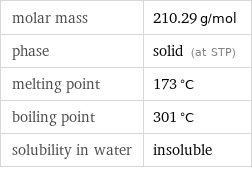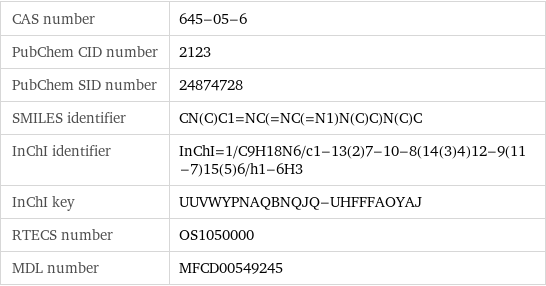Input interpretation

hexamethylmelamine
Chemical names and formulas
![formula | C_9H_18N_6 name | hexamethylmelamine IUPAC name | N2, N2, N4, N4, N6, N6-hexamethyl-1, 3, 5-triazine-2, 4, 6-triamine alternate names | 2, 4, 6-tris(dimethylamino)-1, 3, 5-triazine | 2, 4, 6-tris(dimethylamino)-s-triazine | [4, 6-bis(dimethylamino)-s-triazin-2-yl]-dimethyl-amine | altretamine | hexalen | N2, N2, N4, N4, N6, N6-hexamethyl-1, 3, 5-triazine-2, 4, 6-triamine mass fractions | C (carbon) 51.4% | H (hydrogen) 8.63% | N (nitrogen) 40%](../image_source/fb77f4b64be485efaba48e469d1c1cf5.png)
formula | C_9H_18N_6 name | hexamethylmelamine IUPAC name | N2, N2, N4, N4, N6, N6-hexamethyl-1, 3, 5-triazine-2, 4, 6-triamine alternate names | 2, 4, 6-tris(dimethylamino)-1, 3, 5-triazine | 2, 4, 6-tris(dimethylamino)-s-triazine | [4, 6-bis(dimethylamino)-s-triazin-2-yl]-dimethyl-amine | altretamine | hexalen | N2, N2, N4, N4, N6, N6-hexamethyl-1, 3, 5-triazine-2, 4, 6-triamine mass fractions | C (carbon) 51.4% | H (hydrogen) 8.63% | N (nitrogen) 40%
Lewis structure

Draw the Lewis structure of hexamethylmelamine. Start by drawing the overall structure of the molecule, ignoring potential double and triple bonds: Count the total valence electrons of the carbon (n_C, val = 4), hydrogen (n_H, val = 1), and nitrogen (n_N, val = 5) atoms: 9 n_C, val + 18 n_H, val + 6 n_N, val = 84 Calculate the number of electrons needed to completely fill the valence shells for carbon (n_C, full = 8), hydrogen (n_H, full = 2), and nitrogen (n_N, full = 8): 9 n_C, full + 18 n_H, full + 6 n_N, full = 156 Subtracting these two numbers shows that 156 - 84 = 72 bonding electrons are needed. Each bond has two electrons, so in addition to the 33 bonds already present in the diagram add 3 bonds. To minimize formal charge nitrogen wants 3 bonds and carbon wants 4 bonds. Identify the atoms that want additional bonds and the number of electrons remaining on each atom: Fill in the 3 bonds by pairing electrons between adjacent highlighted atoms. Note that the six atom ring is aromatic, so that the single and double bonds may be rearranged: Answer: | |
3D structure

3D structure
Basic properties

molar mass | 210.29 g/mol phase | solid (at STP) melting point | 173 °C boiling point | 301 °C solubility in water | insoluble
Units

Hydrophobicity and permeability properties

experimental LogP hydrophobicity | 1.7 predicted LogP hydrophobicity | 2.43 predicted LogS | -1.83
Basic drug properties

approval status | approved | small molecule drug categories | antineoplastic agent | alkylating antineoplastic agent dosage forms | oral: capsule

brand names | hemel | hexalen | hexastat
Chemical identifiers

CAS number | 645-05-6 PubChem CID number | 2123 PubChem SID number | 24874728 SMILES identifier | CN(C)C1=NC(=NC(=N1)N(C)C)N(C)C InChI identifier | InChI=1/C9H18N6/c1-13(2)7-10-8(14(3)4)12-9(11-7)15(5)6/h1-6H3 InChI key | UUVWYPNAQBNQJQ-UHFFFAOYAJ RTECS number | OS1050000 MDL number | MFCD00549245
Toxicity properties

RTECS classes | agricultural chemical and pesticide | tumorigen | drug | mutagen | reproductive effector | human data